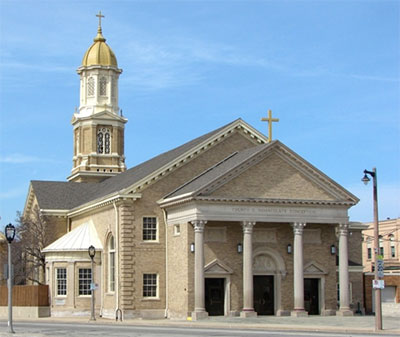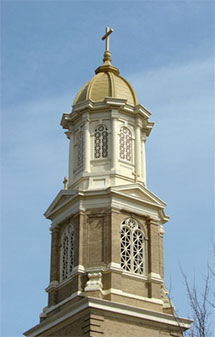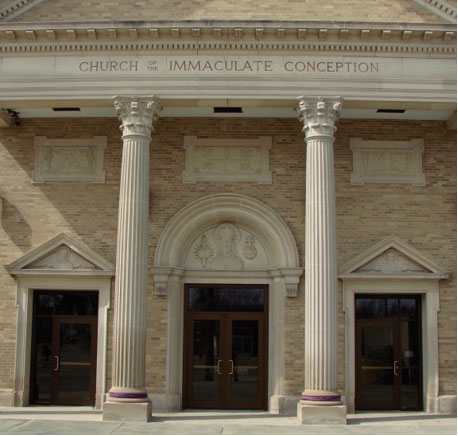7. Immaculate Conception Catholic, 1907
1023 East Russell Avenue (at Kinnickinnic Avenue)
Architects: Buemming and Dick (original building)
Brust and Brust (1959 addition)
In 1868, the Milwaukee Iron Company began production at its facility along the Lake Michigan shoreline south of the city. In just a few years, the sprawling plant had grown to employ more than 1,000 men and the company town of Bay View had sprung up to provide housing for their families, stores, and schools for their children. In 1870, the Milwaukee Iron Company donated land for the construction of a Catholic church, primarily to serve Irish immigrant mill workers and their families. Immaculate Conception Parish built a modest wooden church on the property in 1871. Bay View incorporated as a village several years later, and the village in turn was annexed by the City of Milwaukee in 1887.
By the beginning of the twentieth century, the parish needed a larger church and commissioned the Milwaukee partnership of Herman Buemming and Gustav Dick to design the new building. Construction of the Colonial Revival church began in 1907, on the site of the original 1871 church. The church features a dome-topped tower on the north façade, approximately 120 feet in height from the ground to the top of the cross.
In 1958-59, the parish enlarged the church by constructing an addition at the south end, in conjunction with an unusual reconfiguration of the interior. This work expanded the seating capacity of the worship space from about 600 to 1,000. As originally built, the main entrances to the church were on the north façade on Russell Avenue, with the central doorway at the base of the tower. The expansion included a new entrance on the south façade, relocation of the altar from the south end of the worship space to the north end, and reversing the direction of the pews to face the relocated altar. The north entrances were closed, with a shrine to Mary installed at the base of the tower where the central entrance had been. The shrine was built into the original limestone entryway, with its arched pediment and Ionic pilasters.
The architectural firm of Brust and Brust designed a seamless addition to the church, continuing the rooflines of the original building and using brick of matching color. The addition includes the semi-circular baptistery that projects from the west wall as well as that portion of the main block of the church that extends south of the baptistery. At the south end of the church is a smaller extension with a pediment supported by four Corinthian columns of limestone, each 22 feet in height. Immaculate Conception is a rare and distinctive example of a building comprised of two parts, one being a substantial addition constructed more than five decades after the original portion, which nonetheless forms a visually and stylistically unified whole.
Sources:
Brust and Brust, architects. Drawings for addition and renovations to Immaculate Conception Church, dated April and May 1958. Wisconsin Architectural Archive, Milwaukee Central Library, drawing set 66-129.
Buemming and Dick, architects. Drawings for construction of Immaculate Conception Church, dated May 29, 1907. Wisconsin Architectural Archive, Milwaukee Central Library, drawing set 10-162.
Congregation of Immaculate Conception, 1870-1970. Immaculate Conception Church, 1970.
Janett, Rev. J.P. “Janett Traces Growth of Bay View Church,” Milwaukee Sentinel, February 19, 1927, page 14, column 5.



